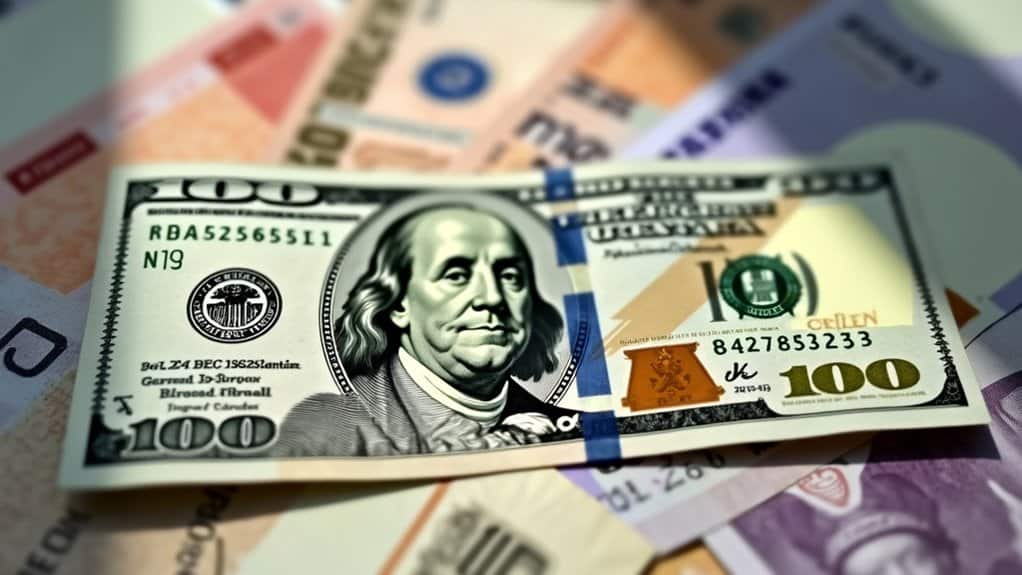The U.S. dollar cemented global dominance post-WWII via Bretton Woods. Decades later, it’s still supreme—roughly 88% of forex trades involve dollars, and nearly 60% of central bank reserves globally are held in greenbacks. This “exorbitant privilege” nets the U.S. lower borrowing costs—saving an estimated $80 billion yearly—and simplifies global commerce from oil to corporate loans. Yet structural inertia faces tests: growing U.S. debt ($20 trillion foreign-held) and sanctions prompt alternatives like China’s yuan (now used in 27% of its trade). The dollar’s plumbing runs deep, but geopolitical friction accelerates the search for bypass valves. Unpacking where this leads reveals the real stakes.
Historical Context and Current Global Standing
Following World War II’s revolutionary upheaval, the U.S. dollar became the globe’s undisputed reserve currency, a status cemented by the 1944 Bretton Woods Agreement that tethered other currencies directly to it and reflecting the undeniable economic clout of the new superpower.
This established the dollar as the central pillar of the post-war financial system, essential for international trade and settling debts globally. You’ll find its role persists powerfully today: nearly 60% of all foreign exchange reserves are held in dollars – over three times the euro’s share.
Roughly 90% of forex trades involve the greenback, facilitating everything from oil deals to corporate loans. The sheer stability and liquidity flowing through the U.S. financial system support its dollar dominance, providing a foundation for global economic growth.
Mechanics of Global Reserve Currency Operations
While you might marvel at how oil deals and corporate loans ping across the world almost instantly, it’s the oft-overlooked machinery beneath U.S. dollar dominance that makes it possible—think global banking’s unglamorous plumbing.
Central banks maintain significant currency reserves primarily in US dollars due to its stability and that 60% global reserve share.
Systems like SWIFT and CHIPS grease the wheels for trillions in global financial transactions. Most international payments (58%), plus nearly all foreign exchange transactions (90%), rely on the greenback.
This vast ecosystem creates deep liquidity pools, allowing traders and nations to easily exchange currencies or buy dollar-denominated securities.
This sheer volume fuels perpetual demand for the dollar, embedding it deeper into the global financial system‘s core processes than any other contender, reinforcing the entire monetary system.
That demand for the dollar ultimately strengthens its indispensability.
Privileges and Economic Advantages for the United States
The dollar’s reserve status lets your government borrow cheaper, saving you about $80 billion yearly in interest costs other nations can’t match this fiscal ease.
It gives your economy dominant trade advantages as global businesses transact effortlessly in dollars, avoiding messy currency conversions and building inherent trust.
You hold unmatched pricing power and payment convenience, smoothing international deals like no other nation can – no small edge.
Lowered Borrowing Costs
Its global dominance gives the U.S. dollar a significant economic edge, directly lowering borrowing costs for government and consumers alike.
Because the dollar is the primary reserve currency, central banks hold ~60% of foreign exchange reserves in it. Investors persistently seek dollar assets, especially U.S. Treasury securities, seeing them as an unmatched safe haven.
This deep demand, fueled by immense global confidence, means Uncle Sam taps debt markets at cheaper rates than others, saving ~$80 billion yearly.
You pay less too. The sheer scale and liquidity of the $28 trillion Treasury market suppresses yields globally.
It’s a structural advantage built on decades of trust.
Dominant Trade Advantages
Nearly six in ten global foreign currency reserves sit in dollars—almost triple the euro’s share—handing U.S. policymakers immense advantage in trade negotiations and crisis management.
You see the dollar’s reach directly enhancing US economic interests:
- Over half of all international trade invoices (54%) use the dollar, simplifying global transactions for everyone, even without direct US involvement.
- About 64% of world debt is dollar-denominated, reducing foreign exchange risks for borrowers worldwide and reinforcing dollar demand.
- Massive foreign reserves stocked in dollars amplify U.S. economic influence and utilize during sensitive international negotiations.
- This demand grants America an “exorbitant privilege”: cheaper borrowing, saving nearly $80 billion annually, enjoyed by its government and consumers.
Measurable Shifts in Dollar Market Share
Despite gradual declines in the dollar’s stranglehold on global reserves—down from over 70% two decades ago to about 59% now—you’d be mistaken to think its overall grip is slipping entirely.
This diversification of reserve currencies signals a shift, prompted partly by the eurozone crisis dampening confidence and rising emerging currencies like China’s renminbi, now used in 27% of its global trade.
Yet, demand for dollar assets soars concurrently: dollar-denominated debt securities surged globally from 49% (2010) to 64% (2024).
The dollar’s dominance remains deeply embedded; financial markets and international transactions still overwhelmingly depend on its foundation.
Its true power isn’t vanishing, just sharing more space.
Geopolitical and Economic Vulnerabilities
You face America’s $20 trillion foreign debt load, casting doubt over long-term dollar stability.
Sanctions drive rivals from Riyadh to Moscow towards alternatives, actively chipping at dollar reliance.
Washington’s recurring political crises, like debt ceiling standoffs, could shatter global confidence overnight.
Sanctions Fuel Alternatives
- Renminbi Adoption: Heavy U.S. sanctions on nations like Russia accelerated its switch; its trade with China now settles primarily in renminbi, hitting $20 billion monthly – double pre-sanction levels.
- China’s Managed Shift: China enhanced global renminbi use strategically; its own trade settled in yuan leapt from 17% to over 27% recently.
- Reserve Diversification: Fearful of U.S. influence, states diversify reserves away from dollars, increasing gold holdings significantly as a hedge.
- The BRICS Hedge: The BRICS bloc investigates a potential common currency, a direct challenge aiming to cut systemic dependence on U.S. infrastructure.
Debt Sustainability Concerns
The very sanctions fueling renminbi adoption and reserve flight also spotlight America’s mounting debt burdens, creating a dangerous feedback loop.
You see massive foreign liabilities – nearly $20 trillion owed overseas – layered atop a colossal national debt exceeding $33T. This looming shadow raises legitimate debt sustainability questions amid geopolitical tensions and perceived fiscal mismanagement, like repeated credit downgrades.
If chronic deficits erode investor confidence in US treasury bonds, it directly undermines the dollar’s reserve currency foundation. Economic sanctions only intensify this vulnerability, pushing rivals faster toward alternatives, triggering potentially punishing capital flight just as those dollars are needed most.
Political Instability Risks
Political dysfunction inside Washington creates unnerving liabilities exceeding $20 trillion owed abroad – it’s actively chipping away at bedrock confidence in the Greenback itself.
Consider these concrete risks:
- Congressional Gridlock & Debt: Repeated threats of U.S. default due to partisan fights over the debt limit trigger credit downgrades and rattle investor confidence globally, directly questioning the dollar’s dominance as the premier reserve currency.
- Debt-Fueled Vulnerability: That very U.S. national debt, nearly $34 trillion total with over $20 trillion in foreign liabilities, creates critical weakness; political mismanagement could shred trust essential for sterling currencies.
- Sanctions Spur Alternatives: You’ll see the politicized application of sweeping economic sanctions breeds resentment, pushing targeted nations to actively cultivate alternatives to the dollar. This accelerates diversification away from traditional global trade channels.
- Systemic Erosion: This potent mix of domestic political instability and aggressive foreign policy corrodes the foundational pillars supporting the dollar’s unique global role, inviting systemic challengers.
Emerging Competitors and Future Trajectory
While cracks appear in the dollar’s monopoly—global reserves dipping from over 70% early this century to about 59% by 2022—the greenback’s rivals are gaining ground, setting a course for a more contested financial terrain.
You see pressure mounting from emerging alternatives, primarily the Chinese renmimbi. Roughly 27% of China’s trade now uses yuan, up from 17%, accelerating as countries like Russia double monthly trade volume with China to $20 billion+, dodging sanctions via non-dollar transactions.
Central Bank Digital Currencies further threaten the dollar’s dominance long-term, offering sleeker pipes for bypassing its plumbing entirely in international transactions and luring global investors seeking diversification after financial crisis memories.
A slow trickle. Its undeniable primacy persists, commanding 58% of non-eurozone payments, but clearly yielding territory.
A more multipolar currency system takes shape, its speed contingent upon America’s choices.
Conclusion
The dollar’s dominance persists – entrenched by network effects seen in commodities trading and 60%+ global reserve share – granting unique pricing power and cheaper borrowing costs. Structural inertia makes displacement hard; see how 2008 and 2020 crises amplified dollar demand as global liquidity surged its home turf. Yet rising multipolar trade flows and central bank hedging, using gold or yuan subtly within reserves, signal a slow diversification likely driven more by strategic hedging than imminent revolt within global financial design. It isn’t going anywhere soon, but it isn’t unchallenged. Managed shifts are the new reality.


Leave a Reply